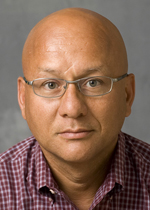www.acsprf.org
Dr. Kenneth Ridgway
 Professor
Professor
Department of Earth and Atmospheric Sciences
Purdue University
Grant 48996-ND8
Geodynamics of Flat-Slab Subduction, Sedimentary Basin Development, and Hydrocarbon Systems Along the Southern Alaska Convergent Plate Margin
Southern Alaska is widely hailed for its dramatic and idyllic terrain. Its diverse landscape serves as a source of inspiration for artists, who seek to capture its beauty, and scientists, who seek to explain its mysteries.
Dr. Kenneth Ridgway is one of these scientists. Concentrating on the southern margin of Alaska, he and his team are employing field-based geologic studies and numerical modeling to evaluate the development of convergent margins, where one tectonic plate is subducted beneath another. Previous studies employed either traditional field-based or computer modeling. Dr. Ridgway and his colleagues’ method is unique in that it combines both approaches.
Southern Alaska is an ideal place for this research, because it contains major faults, volcanoes, and sedimentary basins. The Cook Inlet and Bristol Bay sedimentary basins, in particular, contain a rich stratigraphic database that can provide clues to understanding key stages from the Cenozoic development of the area.
The Bear Lake Formation is considered to be one of the most promising potential hydrocarbon reservoirs in the frontier Bristol Bay basin. Dr. Ridgway and his team have collected new sedimentological and biostratigraphic data from this formation that help piece together the development of this part of the Alaskan margin. They have integrated stratigraphic, sedimentologic, and macrofauna/palynological data to establish the first chronostratigraphic framework for the Bear Lake Formation, which helps to develop an understanding of the depositional systems represented throughout the basin.
Key findings of this research include:
- Non-rigid accommodation of deformation is an important mechanism and is required in any kinematic model of the region.
- Tectonic extrusion likely does not play an important role in the current kinematics.
- The relative motion between the Pacific and Bering plates may be a governing driver in the neotectonics of the region.
- The North America-Pacific-Bering plate boundary is a far-reaching zone of diffuse deformation that extends for more than 1,000 km across Alaska. Using finite element models, we calculate a continuous strain rate and velocity field that provides evidence that a wide zone of diffuse deformation defines the present-day boundaries between the North America, Pacific, and Bering plates in Alaska and western Canada. The importance of this wide boundary was an unexpected result.
Dr. Ridgway’s research provides the hydrocarbon explorationist with some basic stratigraphic and sedimentologic tools for evaluating the Bear Lake Formation, which have applicability to core, well log, and/or seismic data. Also, importantly, a large part of the world’s population lives along convergent margin. These margins are vulnerable to large earthquakes and related tsunamis, volcanic hazards, etc. Understanding how these margins develop and deform can help us make better decisions as a society. Moving forward, Dr. Ridgway looks forward to applying his method of research to further addressing both of these concerns.
PRF support for Dr. Ridgway’s project allowed the two co-PIs (Project Investigators) and one Ph.D. student to expand their research horizons by examining the tectonics of the southern margin of Alaska at many different scales. “Basically we are trying to integrate scales that range from microscopic grains of pollen to the global gravity field.”
For Dr. Ridgway, this has been his first foray into integrating crustal scale basin analysis data with global numerical modeling. Conversely, for co-PI Lucy Flesch, this research has allowed her delve into links between regional scale crustal tectonics and her global geophysical models. This project is the foundation for Emily Finzel’s Ph.D. research. She has gained unique experience in integrating classic field-based, crustal-scale tectonics data with global finite element models.
Dr. Kenneth Ridgway is a professor in Earth and Atmospheric Sciences at Purdue University in Lafayette, Indiana. His research interests include basin analysis, tectonics, sedimentary petrology, and petroleum geology. Dr. Ridgway was the 2011 recipient of Purdue’s Dreamer Award, given annually to an individual or organization whose contributions embody Dr. Martin Luther King's vision of service to others and furthers the university's commitment to diversity.
